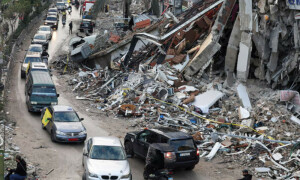Pakistan is fast emerging as one of the top water scarce countries in the world, largely because of its two percent annual population growth rate, which is much higher than the 0.5 percent and around one percent average set for the developed and developing countries respectively, says a Recorder Report.
Pressure on freshwater supply too has increased proportionately, as a result of which a large segment of the population has been deprived of clean drinking water. Spread of such as diarrhoea, gastro-enteritis and Hepatitis B and C has meanwhile burdened the country's health delivery system, with around 20 percent of hospital beds currently occupied by patients suffering from water-borne diseases.
The situation becomes alarming in view of the doctor-patient ratio, which is 1:1,590 (1998 figures). Further, unlike in some African countries, the problem of non-availability of clean water in Pakistan is not restricted to the rural areas alone. The problem, in some cases, has become more acute in urban centres like Karachi and Lahore than in the rural hinterland, while supply of contaminated water by municipal agencies in most cities and towns has aggravated the situation.
As a result, access to safe drinking water is fast emerging as a major national challenge that needs to be addressed on a top-priority basis. While environmental problems resulting from large dams and mega irrigation projects include water-logging, salinity, loss of bio-diversity and aquatic life, contamination of freshwater resources, degradation of mangrove forests, and sea intrusion are equally serious issues that should also be addressed on a priority basis.
A World Bank paper has already characterised Pakistan as an "arid" country, because of the imbalance between the increasing population (at present 160.25 million) and the shrinking availability of water. In fact, famine-like situation has already developed in many parts of the country, including large swathes of Balochistan, Thar in Sindh and Cholistan in Punjab.
Incidentally, the per capita availability of fresh water in Pakistan has dropped from 5,600 m3 in the early 1950s to 1000 m3 at present, which represents over five-fold reduction. The quality of groundwater and surface water has undergone deterioration to an alarming extent, largely because of unchecked disposal of untreated municipal and industrial wastewater and excessive use of fertilisers and pesticides in agriculture.
For purposes of quality of drinking water, experts often divide Pakistan into the following major zones: sweet groundwater areas where water is easily accessible for human consumption; brackish groundwater areas where canal or river water is available; mountainous areas in the north where spring water is frequently available; and the coastal belt where saline water is generally available only at a greater depth.
About 28 percent of the area in Sindh has fresh groundwater which is suitable for irrigation. Here fresh groundwater can usually be found at a depth of 20 to 25 meters. However, what is particularly worrisome is the rapidly receding groundwater table, the speed of which has been calculated at one meter to 10 meters a year.
This means that groundwater may soon become extinct if the causes responsible for the phenomenon are not addressed on an emergency basis. The state of drinking water supply is equally bleak. According to one estimate, about 17 percent of urban and about 47 percent of rural population in Pakistan lacks access to clean drinking water, which accounts for 30 percent of hospitalisation cases and 60 percent of recorded infant deaths in the country. (Pakistan's public sector health delivery system comprises only 852 moderately equipped hospitals, 4,551 dispensaries, 852 maternity and child health centres, and 5,155 semi-equipped rural health centres.)
Mounting fresh water shortage, deteriorating water quality, inadequate funding for water projects, waterlogging, and salinity, groundwater depletion, high sedimentation load and poor drainage are some of the major problems of Pakistan's water sector, which need to be tackled on an emergency basis. Above all, purity of drinking water supply should be ensured because on it depends public health, and hence the country's economic productivity.
The government should install water purification plants to solve this major problem. Further, if solar power is made available for desalination of seawater, the shortage of drinking water in far-flung areas (such as barren lands of Balochistan, and desert areas in Sindh) can be eliminated. This can be done by pumping seawater to remote areas, treating it with solar energy-operated desalination plants and pumping it to coastal villages and other habitations as drinking water. The government should earnestly solve the country's water shortage problem, be it the construction of dams or ensuring supply of clean drinking water.
BR100
10,659
Increased By
569.2 (5.64%)
BR30
31,331
Increased By
1822.5 (6.18%)
KSE100
99,269
Increased By
4695.1 (4.96%)
KSE30
31,032
Increased By
1587.6 (5.39%)



















Comments
Comments are closed.